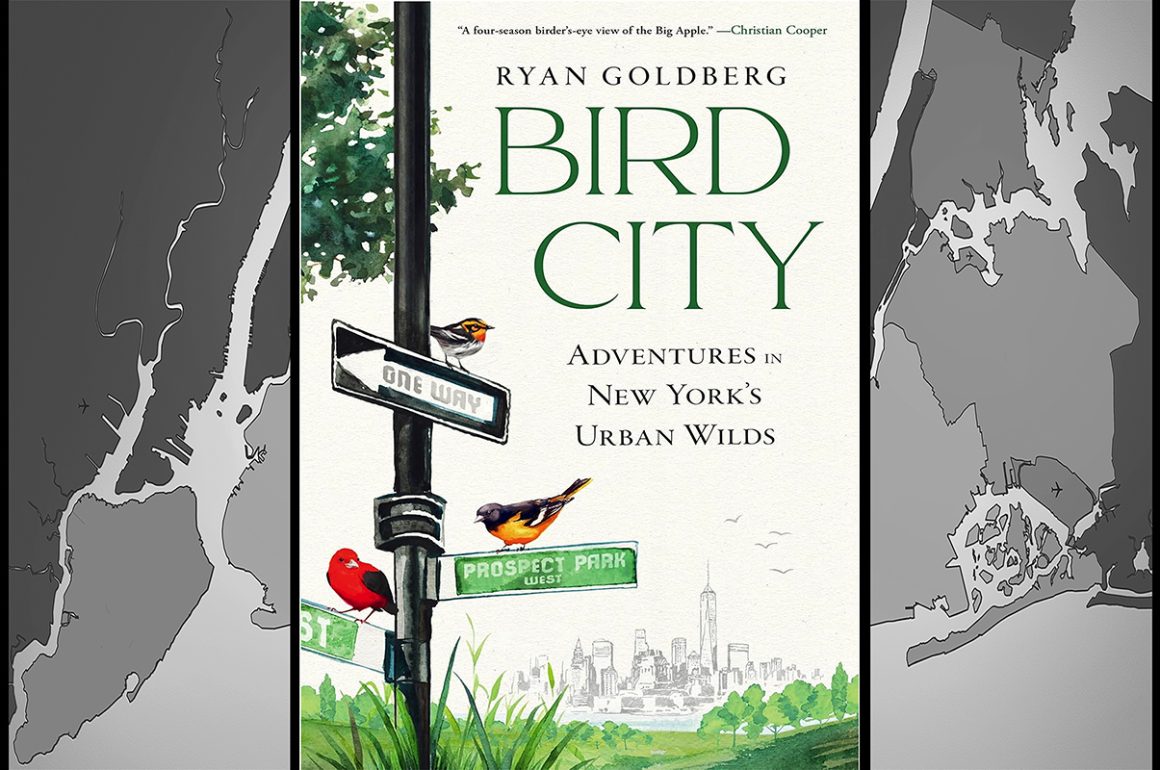
As a born New Yorker, I love books about urban birding, especially if they’re about my home city, so I was intrigued when my Brooklyn birding friend Janet told me that her Brooklyn Bird Club colleague Ryan Goldberg had written a book called Bird City: Adventures in New York’s Urban Wilds. Although Ryan has been birding Brooklyn for about ten years, we had never met, though I his name was familiar as the editor for the Brooklyn Bird Club’s excellent newsletter/magazine, the Clapper Rail. Several months after Janet’s heads-up, I had the opportunity to talk to Ryan about Bird City. Here was my chance to get the questions I always have when I’m reading a book answered, to get the story behind the book. (My formal review will be appearing in one of my other outlets at a later date, which I’ll add to this post.)
Ryan Goldberg has written about sports, crime, the environment, and urban life for Texas Monthly, the New York Times, The Intercept, ProPublica, Vice, Defector, Deadspin, Popular Science, Audubon, the Village Voice, and other publications. He worked for HBO’s “Real Sports with Bryant Gumbel,” winning a Sports Emmy for Outstanding Sports Journalism in 2009, and has also worked on four Olympics broadcasts and a World Cup. He won an Eclipse Award in 2012 for outstanding achievement in horse racing journalism. He’s also a Brooklyn birder, member of the Brooklyn Bird Club, and, as mentioned above, editor of the BBC’s Clapper Rail. You can follow up on Ryan’s publicity activities for Bird City and his other writing projects on his website.
In Bird City: Adventures in New York’s Urban Wilds, Ryan writes about NYC birding and birders as both reporter and new birder, combining research and interviews with personal experiences and friendships. The book consists of 14 chapters organized according to the seasons; topics covered include winter waterfowl counts, Christmas Bird Counts, morning flights, the development of grassland habitats in Staten Island, conservation of the Bronx River, the NYC Plover Project in the Rockaways, conservation of Jamaica Bay and the story of the Jamaica Bay Guardian, Don Riepe, and yes, thoughts on a certain celebrity owl, We had a terrific conservation over the phone a couple of weeks ago; the interview has been edited for clarity. I also added some of my own photos to illustrate some of the habitats and birds that are discussed.
Author Ryan Goldberg, photo by Angie Co, ©2025
DONNA: Can you tell me a little bit about your background? When did you move to NYC and how did you get involved in birding? When did you move to Brooklyn?
RYAN: So, I moved to NYC in 2005, fresh out of college. I grew up on the Jersey shore, so I didn’t live very far from New York, but the city was not very much in my world view at all. I went to college at Brown University in Providence (Rhode Island), and when I graduated, I moved to New York pretty soon after that. I worked in journalism, I’ve been a reporter for a long time. I started at a newspaper called the Asbury Park Press, in 1999 actually, when I was a junior in high school. So, I’ve worked as a reporter for a long time, and when I left college, I came to New York looking for work in journalism. I briefly worked in television news and then set out to continue in print writing, that was what I loved doing. I’ve been a free-lance reporter since 2008. I lived in Astoria for about four months when I moved to New York, but I’ve been in Brooklyn for 19 years, since November 2006. So that’s pretty much all I’ve known in New York. And, the birding came later, it came about ten years later.
I started birding in the spring of 2016, and it was not on my radar at all, I was probably a totally urban creature at that point and had no real connection to nature. My aunt is a birder, she lives in north Jersey and was an active member and former president of the Bergen County Audubon Society, so she introduced me to it. I was visiting my parents in New Jersey, which is pretty close to Sandy Hook, and my aunt was visiting as well, and she said, “Do you want to go birding today?” and I was like, “I don’t have anything to do, sure, I’ll give it a try.” And we went out to a little county park near where I grew up, a place I’d passed thousands of times, and just going out there with binoculars, I was totally captivated. Flipping through the field guide, I was just stunned that there were that many birds we could potentially see. There weren’t that many birds that day, it was early April, but I went again to Sandy Hook in April and then actually my first time birding in Brooklyn was in early May, I think it was May 5th, 2016. I joined a Brooklyn Bird Club walk on a Thursday and just completely fell in with the bird club and the birding community here. I was really captivated. I think I went birding maybe four out of the first five days of that week, and it turned out that that weekend was the best day of that season. I kind of couldn’t believe that. Migration was about to end, what if I missed it all! So, I’m coming up on my, I guess next year will be my first ten years of birding.
DONNA: Which country park in N.J.? I’m curious.
RYAN: It’s called Weltz Park, it’s in Ocean Township, New Jersey. It’s a small place, but there are these woods in the back, and I honestly feel like at that point in my life, I was 33, and I’m not sure I’d ever taken a walk in the woods before. It sounds crazy to say. I think the surprise was that I’d passed this park so many times, but beyond the baseball fields, there was a meadow, there were woods, I was so surprised.
DONNA: In your book you talk a lot about Peter [Peter Dorosh, president emeritus and current field trip leader for the Brooklyn Bird Club, also keeper of a blog about Prospect Park birding]. I take it he was one of your mentors?
RYAN: He was. I met him that first week of birding in Brooklyn. The first walk I joined was on a Thursday, that Sunday was Mother’s Day, and Peter was leading a trip in Greenwood Cemetery. A few days prior to that, several birders I met said: One, you should read Peter’s blog. Two, he’s leading a trip at Greenwood on Mother’s Day this Sunday and Greenwood is a great place to go birding, you should join. And that was when I first met Peter. He really did become a mentor of mine, and then a very good friend as well.
DONNA: And I think I remember from the book, you did have a spark bird, but you didn’t talk much about it.
RYAN: My spark bird was an Eastern Towhee, which I saw at Sandy Hook the second time I’d gone birding. The first time I went birding with my aunt at Weltz Park, we really didn’t see very much. One of the few birds we saw was probably a Kestrel, it was up on the top of the dead tree looking back, but my aunt was like, “It could be a Kestrel or a Merlin.” She pulled up a field guide and we were looking for the field marks. So, because we didn’t confirm it, I couldn’t say that was my spark bird, more like that first day was a Spark Experience.
But then the second time we went, we went to Sandy Hook, and I think it was the last week of April, and it was so quiet, there were no birds around, but one of the only birds we saw at the end was an Eastern Towhee. This bird was up on some cedar trees, it was a male, it was singing, it was giving everything it had into that “drink your tea” song. At that point, it was–I really want to do this. And I didn’t know where you would go birding in Brooklyn, so that night I looked it up, I found the BBC’s website. It was definitely an older website, but the descriptions of the places where you could go birding in Brooklyn, it was like they were describing an entirely different city then the one I was living in. It included places I had been to, like Floyd Bennett Field or, obviously, Prospect Park, but the places they were describing, the species you would see at different times of year, that was when I learned about the bird club. The Towhee was my spark, so I feel very fondly about that bird.
Shorebirds on Pilings, Floyd Bennett Field, Brooklyn (photo not in book), ©2017, Donna L. Schulman
DONNA: How did your book come about? Could you tell me the story of the book?
RYAN: It’s been a long time that I’ve wanted to write a book, and over the years I’ve had a few ideas that I thought I might pursue. Earlier in my writing career, I was kind of an investigative writer, always freelance but covering sports. I wrote a lot about horse racing, there was an opportunity to write a book about horse racing, but I started to become more interested in other subjects, and obviously, once I started birding, I was just doing it all the time. I felt like it was an education. I wanted to start writing about that, also urban ecology, the people I was meeting. I had been talking to an agent named Elias Altman for quite a while after a story I wrote for Texas Monthly came out in 2017. So, I was keeping in touch with Elias about different book ideas. If I’m honest, an early idea was writing about Don Riepe, who’s in the book, writing about him and Jamaica Bay.
At the end of 2021, almost four years ago, I was working on a few different ideas. I was in my apartment, I live just south of Greenwood Cemetery and Prospect Park, and I can see Greenwood from my apartment. I can see the southern ridge of the cemetery, and I was in the bedroom, which looks west, and it was dusk and there were a number of Common Nighthawks coming out of the cemetery. I had seen them before, obviously, but there was something about seeing them coming south out of the cemetery from my apartment and almost feeling like I might be the only one seeing these birds at this moment. It was something that just hit me—the things I’ve been doing, the people I’ve been meeting, the experiences I’ve been having, the experiences that other people I knew have had and were having in birding in New York, was this aspect of the city that not many people knew about, and I thought it was just really worth going deeper into it. It was aligning what I was really passionate about personally with professionally what I was going to do. I talked to my agent, and he responded, “I think it’s a great idea, the birds of New York.” I knew, obviously, there was such a great history of natural history books about the city, so I also knew I’d be working from a place of a wealth of information to pull from. I also felt like the moment–there were so many new birders that got into it in New York during the Pandemic. I felt like there was also something happening a little bit in the birding world, and certain things I wanted to write about, like Fresh Kills, the Piping Plover Project, things that were new. I felt like I could contribute to this great history of writing about the natural world, the natural history of New York.
So, that was where it started and then in 2022, I spent most of that year working on the proposal, and then I sold the book to Algonquin in October 2022. I spent the next two years doing the reporting. I’d been doing reporting leading up to that proposal, and there’s some scenes that even predate that, like the opening scene of the book when I’m counting ducks with Peter in the Winter Waterfowl Count, but the bulk of the reporting was over the next two years.
Piping Plover, the Rockaways, Queens, now protected by the NYC Piping Plover Project (photo not in book); ©2020, Donna L. Schulman
DONNA: So you had the proposal in hand when you started writing it?
RYAN: The proposal took me eight months to do, to really get it right. And what’s kind of amazing, the moment of it all coming full circle, is the day the proposal went out, it was September 22. The reason I remember the date is that the following day was this huge Broad-winged Hawk flight, which I actually wrote about in the book in the second to last chapter, but the day before was the day my proposal went out, and I remember in the morning, Elias called me and said, “You’re probably not going to hear from me for the next two weeks. Don’t read into the silence, editors will be reviewing it, and it’s no reflection if it takes some time to hear.” And at that point, I was like, “Is this any good? Do I even have a chance here?” He allayed my concerns, and I wanted to clear my mind, and so I went into Greenwood that afternoon and it was the beginning of a huge cold front, and the winds had shifted kind of mid-morning, a storm had passed through in the morning from the south, and the winds had started coming through from the north and all of a sudden the skies were clear, the temperature was dropping, and then I was up on Ocean Hill in Greenwood and this really huge flight of Common Nighthawks just started happening, they just started streaming south down the hill, and I was like, “What am I seeing?” It was an hour and a half before sunset, and then Elias called me, and I was like, what’s he doing calling me, I didn’t expect to hear from him for two weeks, and I didn’t know if I wanted to answer him because I was watching something really special in that moment. But I did answer, and he said, “An editor has read it and they already want to meet with you.” So in that moment I felt–this is already a good sign. But then I very quickly got off the phone with him because I wanted to count how many nighthawks there were.”
DONNA: You’ve become a true birder!
RYAN: I know!
DONNA: I think a lot of people think they can write a book, and it isn’t that easy.
RYAN: No, it’s not. So much work that goes into the proposal. Ultimately, if you put into the hard yards in the beginning, it really does pay off. The structure of the book did not really change much at all from the structure I had in the proposal. I added two chapters, but largely the seasonal structure of the book was already established, and even some of the reporting that I had done for the proposal found its way into the book. It can be a lot of hard work and obviously unpaid work until and unless you get a good outcome, but it really does pay off.
DONNA: I was very impressed by how you brought natural history and New York’s bird history into it. You mention Frank Chapman and the geological history of New York. You went to the museum to talk to Paul Sweet. You do a good job integrating that into the narrative, which I don’t think is easy.
RYAN: Thank you.
DONNA: Which were the two chapters that were added?
RYAN: One was the Bronx River. I wanted to have all five boroughs represented, so I felt very quickly, “What can I do in the Bronx?” I knew very little about the Bronx River, so in the end that was one of my favorite chapters to write because it was so much discovery for me. I think the other chapter that wasn’t in the book was morning flight. I wanted to write about morning flight, but I wasn’t sure if it was going to be its own chapter or kind of weave it into something else. I think perhaps the last two chapters of the spring section, Morning Flight and Wave Day, might have been one chapter but ultimately became two chapters. If I was able to experience a great day of morning flight with Doug Gochfeld, it would merit its own chapter. And it’s a short chapter, maybe the shortest chapter in the book.
Sanderlings at Breezy Point, Queens (photo not in book); ©2019 Donna L. Schulman
DONNA: Yes, I went through and listed the boroughs you covered in the chapters. So many books about New York focus just on Manhattan or Brooklyn, and if you live in Queens, it’s annoying. You have Jamaica Bay, of course, which is in Queens, and Fort Tilden, so Queens is represented, even though some of the Queens parts are with Brooklyn birders.
RYAN: We have that with the Christmas Bird Count too. [Ryan writes about how the CBC circles for Brooklyn, Queens, and Nassau County historically overlapped and how the conflict was resolved with Brooklyn getting key parts of Queens as part of its CBC circle.]
DONNA: Oh my gosh, yes, I was very impressed that you included that whole kerfuffle in the book, still a sore spot with Queens. I think this is the only book that has included the CBC wars. I’m curious where you heard that from?
RYAN: It was definitely the compiler for the Brooklyn CBC, Michael Yuan, who put it up on the slide show that he starts the compilation with, but I think I’d already known it before. It might have been from 10,000 Birds, a post of Corey’s some years ago. And I’m not totally sure, I went through the BBC Archives, it could have been in there as well.
DONNA: I was curious about the representation of the five boroughs,* and I noticed there was one chapter on Staten Island and one chapter on the Bronx. Very good. The Fresh Kills story is really important and not that well known.
RYAN: Yeah, absolutely. And the fact is that what’s happened there with the grassland species, especially the Grasshopper Sparrows, has really dictated the future of the park. But those things are never fixed. So, the fact that more birders know about it, and more conservationists know about it, will be important because in the future there could be different park management or an administration that says, “Let’s build a road though this huge Grasshopper Sparrow colony.” I hope that wouldn’t happen, but I think the more people that know about Fresh Kills the better because it’s amazing what’s happening there, it really is, and I think so many birders are eagerly anticipating when they can get in and see more of the place.
DONNA: Is there anything—an event, person, experience- that you wanted to include in the book, but you could not or did not for some reason?
RYAN: I also wanted to write a chapter that really focused on shorebirds in the fall. I had sorta sketched out essentially the idea of ephemeral habitat in New York, you know, habitats that are there and then gone. Some are intentionally so, like the East Pond at Jamaica Bay, drawing down the water to create mudflats, but even ones that are not intentional, that are maybe natural, like the Plumb Beach flats that go out with the tide. And then there are habitats that are not intentional, maybe not even natural either. A story that I love, that I would have loved to include, was about the potholes at the Orchard Beach parking lot in May. In 2017, the parking lot there buckled and sank and a lot of potholes formed and those potholes filled with rainwaters and then shorebirds started landing there. For three months it was a shorebird extravaganza and you didn’t have to go sink in the mud at the [Jamaica Bay] East Pond to get great photos of the incredible diversity of shorebirds that appeared there. I remember, there was a Red-necked Phalarope that showed up in a puddle, a Stilt Sandpiper, I think a Whimbrel, all the peeps as well. It was an amazing place. I remember Jack Rothman, a longtime Bronx birder, was posting daily updates on his website, he even did the first ever Orchard Beach Puddle Walk. So that was amazing.
I’m actually writing an essay I’m going to try to place in the next few weeks, hopefully, that looks at this idea, at these chance ecologies, this accidental wildness. I feel is so interesting and unique to cities, where the built environment occupies so much of the land but when there are spills or leaks or things like that you start to see bird life come in. It just shows how little habitat there is, that then when habitat appears, especially for shorebirds, how important it is to have even a stopover for a few days or a few weeks. That is something I would have written, but I just didn’t have the time. Originally the book was going to be 12 chapters, for a long time then I had 16 chapters lined up, then at some point I was like, I can’t do another chapter and meet my deadline and do more reporting. And my wife Angie, who’s a great birder as well, said “You’re not doing another chapter, this is it, I’m cutting you off at 14.”
 Greater Yellowlegs enjoying a temporary puddle habitat at Flushing Meadows Corona Park, Queens (photo not in book). @2024, Donna L. Schulman
Greater Yellowlegs enjoying a temporary puddle habitat at Flushing Meadows Corona Park, Queens (photo not in book). @2024, Donna L. Schulman
DONNA: This goes back to the making of book, how did you decide on the black-and-white drawings that illustrate each chapter?
RYAN: The interior illustrations were done by Aimee Lusty. Aimee is an archivist at the Montauk Library who is also a master naturalist and incredible illustrator and artist. I met her a little more than two years ago when she was living in Brooklyn and at the time working at the Center for Brooklyn History, and when I thought about having illustrations for the book, she was the first person who came to mind. I’d seen some of her work elsewhere, so that was a wonderful thing. I thought the illustrations she created were just beautiful. I wanted to have an older natural history style, but I think she brought a fresh take on it. We went back and forth–would we have illustrations in each chapter, maybe have small ones sprinkled about? I looked at a lot of different nature books going back many, many years, some of my favorite books, to see what they had done. The publisher really pushed to have one at the start of each section, having it full-page instead of interspersed through the text or even at the end. I’ve heard from a few friends who are not birders, they’re not even really interested in birds, who have read an advance copy of the book, and one friend told me, “I would have loved an illustration at the end of every chapter with the birds that were in that chapter.” But I think this was a happy medium.
DONNA: Do you do photography yourself?
RYAN: No, I don’t.
DONNA: What’s wrong with you? (I’m joking.)
RYAN: I know, I feel like the odd man out and I think maybe more experienced birders potentially look down on me. Oh, they’re probably not even thinking about me. I don’t have photos to put on eBird, unfortunately, but I tend to go birding with people with cameras, so if we see something rare, they can get a photo of it.
DONNA: You don’t carry a camera in case you see a huge rarity?
RYAN: No, I don’t, and I actually did see a huge rarity in Greenwood some years ago, which was a Zone-tailed Hawk. I think it was the first New York record. There were two people who saw it almost simultaneously, they were nearby in the cemetery, we weren’t together. My group saw it and a friend of mine had a camera and he didn’t even lift up his camera. None of us knew it was a Zone-tailed Hawk right away, we were just like, “That didn’t look like a Turkey Vulture, the tail was different and the flight style was different, and why was a Red-tailed Hawk chasing it away, it’s not like a Turkey Vulture would be a threat?” and at that moment the other two people who had seen it posted a photo on the What’s App Rare Bird Alert asking “Is this a Zone-tailed Hawk?” and we were like, “That’s the bird we just saw!” We got bailed out because I don’t think anyone would have believed us.
DONNA: That’s amazing. And that’s why you have to carry a camera!
RYAN: I’ve been thinking about it more seriously. The cover of the book, that illustration was done in-house.
DONNA: Yes, I noticed that. It’s cute! The last question is: if you were going to write a sequel, any recent events you would include, or would you write about a different topic? What’s your next book.
RYAN: It’s a hard question to answer. I do feel like if I were to write a sequel, it probably wouldn’t be as bird specific, although the book is about the people too. That was my guiding light, the people, the people stories, that’s always been my north star as a reporter. I do think that what is happening in the Bronx, along the Bronx River and the restoration of that river, also the habitat throughout the borough, I would like to write more about that. I don’t know, it’s probably not a whole book, and Ian Frazier just came out with a book some months ago about the Bronx, but I think that’s something I’d like to explore more. There are restoration efforts happening on the river in terms of pollution, and in terms of removing dams from the river that I didn’t really get into in the chapter I wrote. Those are two topics I think are really fascinating. You hear about removing dams from huge roaring rivers in the west, but not a 23-mile fresh water river in New York City and Westchester, so that’s a cool story.
Also, I’m just so fascinated by this phenomenon of morning flight. Reading the book, you probably see that, it’s so fascinating to me and it does seem like an aspect of migration that still has some mystery to it, as far as why birds do it and what it tells you about how birds navigate the landscape. It would be fun to write more about that in the future.
DONNA: Thanks so much for talking to me and 10,000 Birds readers about your book!
*New York City is politically divided into five boroughs: the Bronx, Brooklyn, Manhattan, Queens, and Staten Island. The boroughs are also counties, although the names are different in some cases: Bronx County, Kings County, New York County, Queens County, Richmond County.
Bird City: Adventures in New York’s Urban Wilds
by Ryan Goldberg, illustrations by Aimee Lusty
Algonquin Books, Nov. 2025, 288pp.
ISBN-10 : 1643755560; ISBN-13 : 978-1643755564
Hardcover, $28, also available in eBook formats




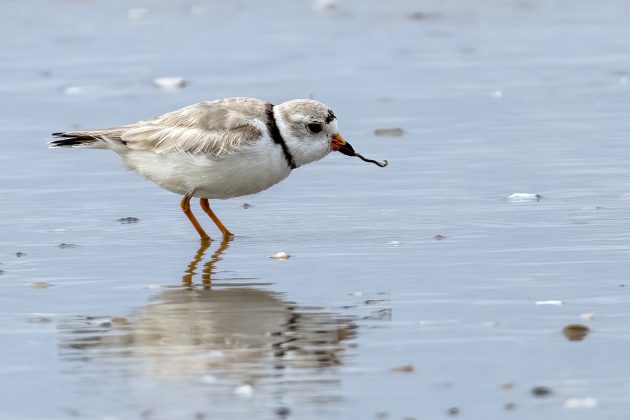

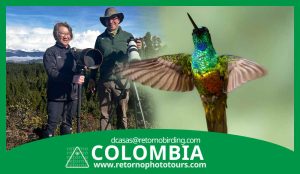

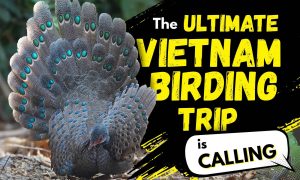
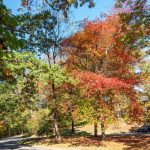
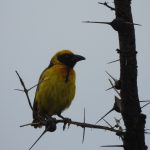

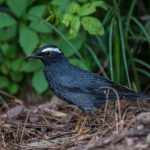



Leave a Comment